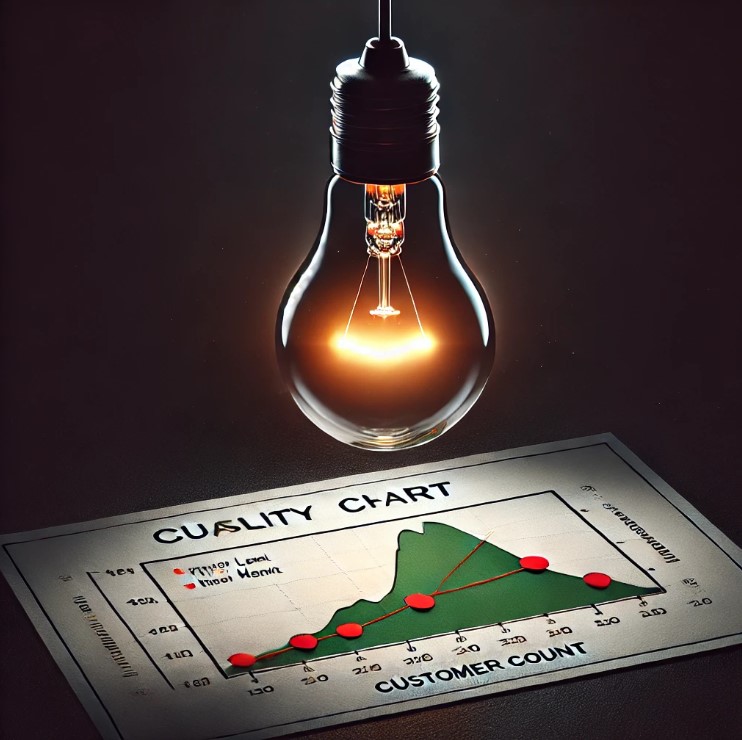Making Data Actionable: How to Move from Insight to Impact
Published: April 2, 2025
By Amy Humke, Ph.D. Founder, Critical Influence

How often have you found yourself staring at the latest data results or a shiny new dashboard, only to draw a blank on what to do with it? Or maybe it’s only then that you realize you requested the wrong data in the first place.
No, it’s not just you. This is a common situation nearly everyone faces at some point in their career.
Early in my career, I frequently received broad requests like, “Can you give me enrollment data from the last five years, broken out by demographics, college, and program? I need to see why enrollment is dropping.” I’d deliver a polished set of line charts, complete with labeled axes and well-organized breakouts, only to hear back that what they actually needed was application data instead.
If I was lucky, the requests stopped there. But more often, it spiraled into a string of follow-up questions and additional data pulls.
So What’s the Real Problem Here?
Seeing data almost always leads to more questions, which is natural. But if that cycle isn’t grounded by a clear purpose, it can easily tip into analysis paralysis: too much data, too little direction, and no clarity on what decision to make or action to take.
Getting the right data—and recognizing it when you see it—doesn’t magically happen at the end. It has to be defined at the outset. When the foundation is solid, actionable data emerges: the path forward becomes clear, decisions gain confidence, and resources are used with purpose.
In this article, I’ll walk you through four steps to move from insight to impact:
- Why are we doing this? Clarifying the question being asked
- What does “done” look like? Setting targets and defining “good enough”
- Start at the end to find your beginning. Getting to actionable
- You have it, but can you see it? Effective data visualization
Why Are We Doing This Again? Clarifying the Question Being Asked
If you aren’t careful, you can fall into a pattern of taking on data requests reflexively, treating them like tickets to be cleared instead of opportunities to solve real problems. You do them because someone asked—not because they support a key decision or metric. That’s a fast track to low-impact, unactionable work.
Start by identifying the stakeholder’s actual pain point. What are they really trying to accomplish? What decision do they need to make? And how will data help make that decision better or faster?
Pro tip: Try the 5 Whys approach, popularized by Sakichi Toyoda. Here’s a playful, exaggerated version:
- Stakeholder: I need conversion rates at each point in the funnel.
- Analyst: Why? What are you hoping to do with that information?
- Stakeholder: End-stage conversions are down 20%, and I need to understand why.
- Analyst: Why? What’s driving the urgency?
- Stakeholder: It’s tied to our quarterly KPI. We’re behind target.
- Analyst: Got it! So our goal is to increase enrollment by lifting funnel performance, especially at the end stage. Let’s isolate the biggest drop-offs and identify actionable levers.
You don’t always need to go five layers deep, but even asking one or two additional questions can reveal the real problem behind the request.
What Does "Done" Look Like? Setting Targets and Defining "Good Enough"
Once the question is clear, the next step is to define what success looks like. Too often, goals sound like “Let’s increase X,” or worse, “Let’s just see what happens.”
Without a clear target, you end up making decisions in hindsight, influenced by the effort already spent. Setting thresholds upfront prevents this trap.
Ask:
- What’s the minimum impact worth acting on?
- What result justifies scaling or stopping?
- How will you know if your effort paid off?
Clear targets make analysis more focused, decisions more confident, and time better spent.
Start at the End to Find Your Beginning: The Hypothetical Results Conversation
Once you’ve clarified the question, ask the stakeholder to imagine the results.
- What will you do if the numbers show X?
- What if the results show Y?
For example: If final-stage conversions are the only ones down, what action does that trigger? If mid-funnel conversion drops but final-stage looks fine, does that change your plan?
These hypothetical scenarios help define what’s actually in scope, and what decisions really matter. They sharpen focus before you even start pulling data.
Seeing the Signal: Designing Visuals That Drive Action
You’ve built the right foundation. Now, make sure your insights don’t get buried.
A great visualization doesn’t just show what happened; it makes the next step clear.
- Use confidence intervals or significance flags to highlight meaningful differences.
- Use control charts for trend analysis to highlight when changes exceed normal variance.
- Add visual thresholds (like a minimum ROI line) to show what “good enough” looks like without relying on p-values alone.
Remember: the best visualizations don’t just inform—they drive action.
Bridging the Gap Between Data Teams and Stakeholders
You’ve seen how to get actionable results in four steps, but don’t overlook the final key: collaboration.
Stakeholders bring context. They know the processes, pain points, and policy shifts behind the numbers. Keeping them in the loop avoids misalignment—and sometimes, as the data unfolds, it takes the project in a direction no one expected at the start.
